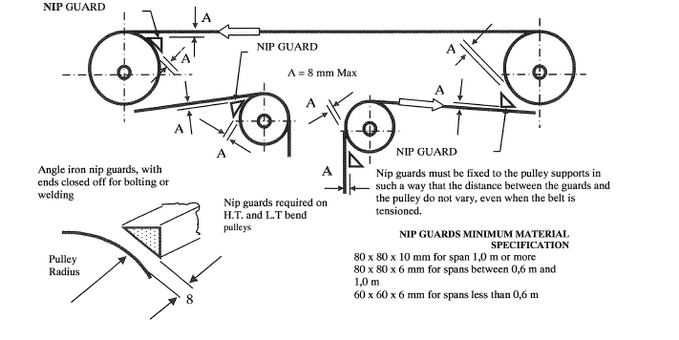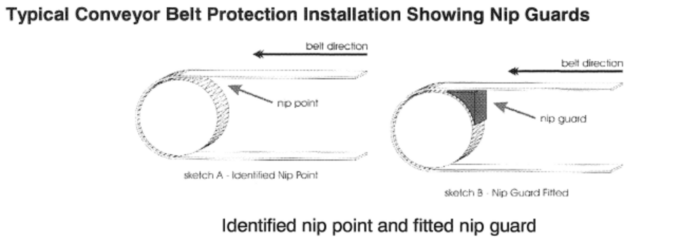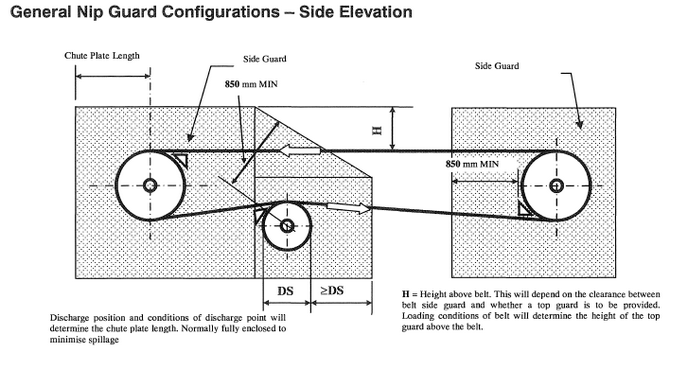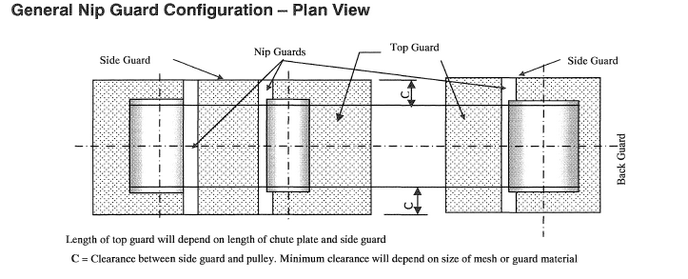 Public Service Commission Act, 1997
Public Service Commission Act, 1997
R 385
Mine Health and Safety Act, 1996 (Act No. 29 of 1996)RegulationsGuideline for a Mandatory Code of PracticeSafe Use of Conveyor Belt Installations for the Transportation of Mineral, Material or PersonnelAnnexuresAnnexure B: Minimum Performance StandardsConveyor System Protection DevicesNip Points and Nip Guards |




Drive units
Driving belts, chains and couplings between driving motors and gear boxes or drive pulleys must be effectively guarded. Experience has shown that even when transmissions are apparently inaccessible they can still be a hazard. If the driving mechanism or any other part is fenced off completely in such a way that access thereto can only be gained through a gate or door forming part of the fencing, then this gate or door should be interlocked so that the conveyor stops when the gate or door is opened.
Interlocked guards
In some applications guards are fitted in conjunction with limit switches interlocked with the safety system such that if a guard is removed, power to the conveyor is immediately cut and the conveyor will coast to a stop. Equally so, the conveyor will not start up if the guard has not been replaced or re-fitted correctly after maintenance has been done E.g. should a pulley be fully fenced and guarded and in addition be equipped with an electric interlock which switches the system off and prevents it from starting when a gate is opened or any one of the guards is removed, the fitting of nip guards may be considered as optional.
To keep the pulleys clean, suitable mechanical devices must be installed.
The manual removal of build-up shall not be permitted whilst the belt conveyor is in motion. It is often necessary for an attendant to cross a conveyor at various points. It is dangerous to climb onto the moving belt. Where it is impossible to establish safe passageways underneath the belt, crossover bridges with handrails must be provided.
The position of these bridges will depend on conditions at the conveyor belt installation, but unless a sufficient number are installed, they will not always be used.
The crossover bridge must be accessed via stairs equipped with handrails and a toe-board (or kick-flat) as well as an intermediate or knee rail. Avoid vertical ladders.
In many cases where walkways are fitted on elevated conveyors, no adequate hand and knee rails are installed on the outer sides of the conveyor stringers. This presents a danger, as there is often a large opening between the inside of the walkway and conveyor stringer section at knee height. These areas shall be guarded off with knee rails and kick flats.
Safety at conveyor belt installations may be further enhanced by creating the optimum working environment including not only adequate ventilation, illumination and absence of undue noise, but also sufficient clearance around the installation and along walkways. Walkways should have an even, non-slip surface, be properly drained and free from obstructions.